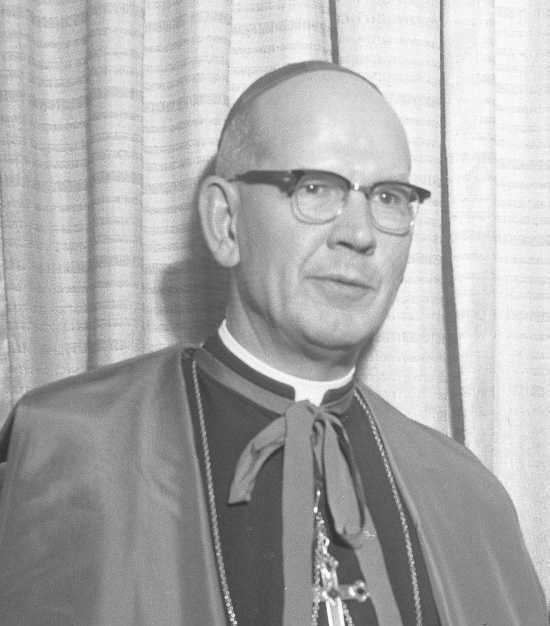Installed 1962 Term ended 1977 Died December 20, 1993 Appointed 1956 | Name Charles Helmsing Ordination June 10, 1933 Denomination Roman Catholic Consecration April 19, 1949 | |
 | ||
Born March 23, 1908Shrewsbury, Missouri ( 1908-03-23 ) Parents George and Louisa Helmsing Education St. Louis Preparatory Seminary Motto Servus tuus, filius anciliae | ||
Alma mater Kenrick–Glennon Seminary | ||
Charles Herman Helmsing (March 23, 1908, Shrewsbury, Missouri – December 20, 1993) was an American prelate of the Roman Catholic Church who served as bishop of the Diocese of Kansas City–St. Joseph (1962 - 1977).
Contents
History
Helmsing was born to George and Louisa Helmsing. He entered St. Louis Preparatory Seminary and then went on to Kenrick-Glennon Seminary before being ordained a priest for the Archdiocese of St. Louis on June 10, 1933. He became a papal chamberlain (monsignor) on February 15, 1946.
On April 19, 1949, Helmsing was consecrated auxiliary bishop of St. Louis under Cardinal Ritter. He took a marked interest in the propagation of the faith, the instruction of converts, the work of the Legion of Mary, as well as both foreign and home missions. He worked as secretary and master of ceremonies for Cardinal Ritter and took on a number of other positions, including Director of the Diocesan Society for the Propagation of the Faith.
In 1956, when Pope Pius XII divided Missouri into four dioceses, Helmsing was appointed first bishop of the Diocese of Springfield–Cape Girardeau. He was installed as bishop there on November 28, 1956.
After the Diocese of Kansas City–St. Joseph was left vacant upon the appointment of Bishop Cody as coadjutor of the Archdiocese of New Orleans, Pope John XXIII looked south for his successor. Helmsing was appointed bishop of the Diocese of Kansas City – St. Joseph on January 31, 1962.
In his installation homily on April 3, 1962, Helmsing explained his motto:
"In the sacrifice of the Cross, Christ our Lord identified Himself with the Old Testament servant of Yahweh, the slave of Almighty God, foretold by the prophets. It was this realization that impelled me to take as the motto of my life and work as a Bishop, the inspired words of the 115th Psalm,
Servus tuus, filius anciliae
“O Lord, I am Thy slave and the son of Thy handmaid”.
It is in this spirit that I come to you with humble determination aided by our Lord’s grace to imitate Him as the slave of the Lord Who became obedient unto death, even the death of the Cross; and also in imitation of His Mother, Mary, who when the greatest possible task was given to her of mothering the Son of God, referred to herself “Behold the slave-girl of the Lord”.
Participation in Vatican II
At the time of his installation, Helmsing was already making preparations for his participation in the Second Vatican Council, which was to convene for its first session that coming fall. He took with him (future Cardinal) William Wakefield Baum, who was vice chancellor at the time, as a peritus (expert). Although it is difficult to trace Helmsing's activities at the council, some incidents are recorded in histories and commentaries. During the initial debate on the schema for liturgy (De Sacra Liturgia), a note is made of his intervention on point no. 39 on the importance of the homily in the liturgy.
Mathijis Lamberigts notes that Helmsing argued that the homily ought to be systematic and theologically well founded. Helmsing took part in all four sessions of the Second Vatican Council and was most influential in the composition of the Decree on Ecumenism(Unitatis Redintegratio). In November 1963, Helmsing was elected with eight other bishops to the Secretariat for Christian Unity which worked under Cardinal Bea to collect statements to the secretariat concerning the schema. The result was 1,063 pages published in six volumes. This helped to prepare revisions to the schema which were returned to council fathers.
National Catholic Reporter
In 1968 the National Catholic Reporter (NCR) was officially condemned by Helmsing for "their policy of crusading against the Church's teachings".
When the paper was first founded, Bishop provided diocesan office space and funds until the paper was able to move to the building where it continues to this day. In the late 1960s, Helmsing objected most specifically to the paper's strong stands on birth control, priestly celibacy and criticism of the hierarchy, citing an imbalance in news coverage. 66 Catholic journalists signed a petition during this time to support the stances of NCR.
Legacy
Helmsing returned to Kansas City, where he supported civil rights and brought home the documents of the Second Vatican Council and was responsible for implementing them in the diocese.
Helmsing served as bishop of Kansas City – St. Joseph until 1977. He died December 20, 1993, aged 85.
The Helmsing Institute
In the fall of 2006, Robert W. Finn, bishop of Kansas City – St. Joseph, named a new adult faith formation initiative of his diocese after Helmsing. The Bishop Helmsing Institute offers a three-year faith formation program and has four full-time instructors.
